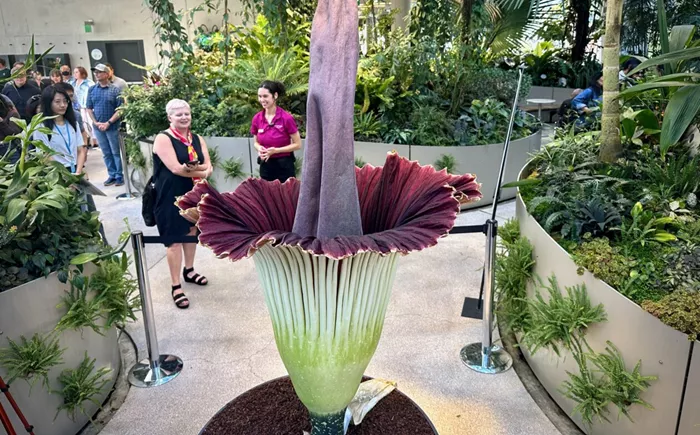Corpse flowers, also known as titan arum, are famous for their huge size and strong smell, which resembles rotting flesh.
These rare plants bloom only for 24 to 48 hours, attracting thousands of visitors to botanic gardens worldwide eager to see and smell them. Despite their popularity, only about 162 corpse flowers remain in the wild, making their conservation critical.
A new study published in the journal Annals of Botany reveals that botanic gardens face a serious problem: poor recordkeeping. The data on corpse flowers is often incomplete, inconsistent, and scattered across many institutions.
This lack of good records is causing unintentional inbreeding among the plants, which reduces their genetic diversity and threatens their survival.
Lead author Olivia Murrell, a plant biologist, explains that gardeners do not deliberately inbreed the plants; they simply do not have enough information about the plants’ genetic backgrounds due to incomplete records. Inbreeding can cause problems such as less pollen production and plants dying soon after blooming. For example, one garden had albino corpse flower offspring that did not survive because they lacked chlorophyll, likely due to inbreeding.
Low genetic diversity also makes the plants more vulnerable to diseases and pests, which could affect the entire population if they are genetically similar. Murrell warns that without changes, corpse flowers could inbreed themselves into extinction.
The researchers gathered data from 111 institutions across North America, Asia, Australia, and Europe, covering nearly 1,200 titan arum plants. They found that 24% of these plants were clones, and 27% were crosses between related individuals. Most plant exchanges happened within the same continent, with very few transfers between continents. DNA tests on 65 plants confirmed low genetic diversity and high inbreeding.
Experts say botanic gardens must improve their recordkeeping and collaborate more globally to save this iconic species. Stephen Jones, a horticulturist at the U.S.
Botanic Garden, notes that the botanical community is starting to adopt better data management practices, similar to those used by zoos for animals. New software tools and plans for centralized databases, or “studbooks,” aim to track genetic information and prevent inbreeding.
The corpse flower’s unique features—such as producing heat and a strong odor to attract pollinators like flies and beetles—make it a fascinating but difficult plant to conserve.
Its seeds cannot be stored in seed banks because they lose viability when dried, and male and female flowers bloom at different times, requiring human help for pollination. These challenges, combined with habitat loss and climate change, have pushed the species to endangered status.
This study on corpse flowers also highlights broader issues in plant conservation. Murrell is now investigating similar problems in tropical carnivorous pitcher plants, where data gaps are even worse.
The findings emphasize the urgent need for better global cooperation and recordkeeping to protect endangered plants before it’s too late.
In summary, while corpse flowers continue to captivate the public, their survival depends on improved recordkeeping and international teamwork among botanic gardens to maintain healthy, genetically diverse populations and prevent extinction.

